Palouzes, in Cypriot dialect or Moustalevria in Greek, is a pudding made with either fresh grape juice during autumn or with concentrated grape juice (petimezi or epsima, in Cypriot) when no fresh juice is available.
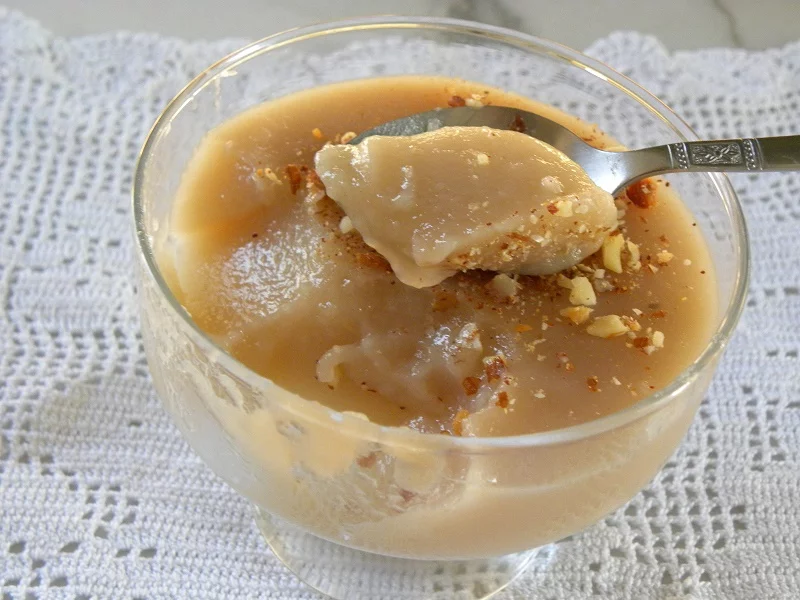
Must (in Greek moustos and in Latin vinum mustum, meaning “young wine”) is freshly pressed grape juice.
Moustalevria in Greek, from “moustos” = grape must and “alevri” = flour or Palouzes in the Cypriot dialect, is a pudding made with these two basic ingredients.
It is usually flavoured (optional) with arbaroriza (kiouli, in Cypriot), which are scented geranium leaves, vanilla or mastiha (mastic resin). These ingredients are boiled together until the pudding thickens.
I am not sure about the origin of the Cypriot name of this pudding but I’ve seen Middle Eastern recipes with the name “balouza” which is a kind of pudding made with fruit juice or milk and corn flour (starch), so I think it may have some kind of connection.
Grape juice, usually from red grapes is used but it can also be made with white grape juice. It is equally delicious but when using white grapes the colour is much lighter.
The best time to make palouzes is September to October, when the grapes are sweet and cheap.
However as I wanted to share this recipe with you in time, last Tuesday when I went to the farmers’ market, the grapes were at a reasonable price so I bought some sultana grapes to make this dessert.
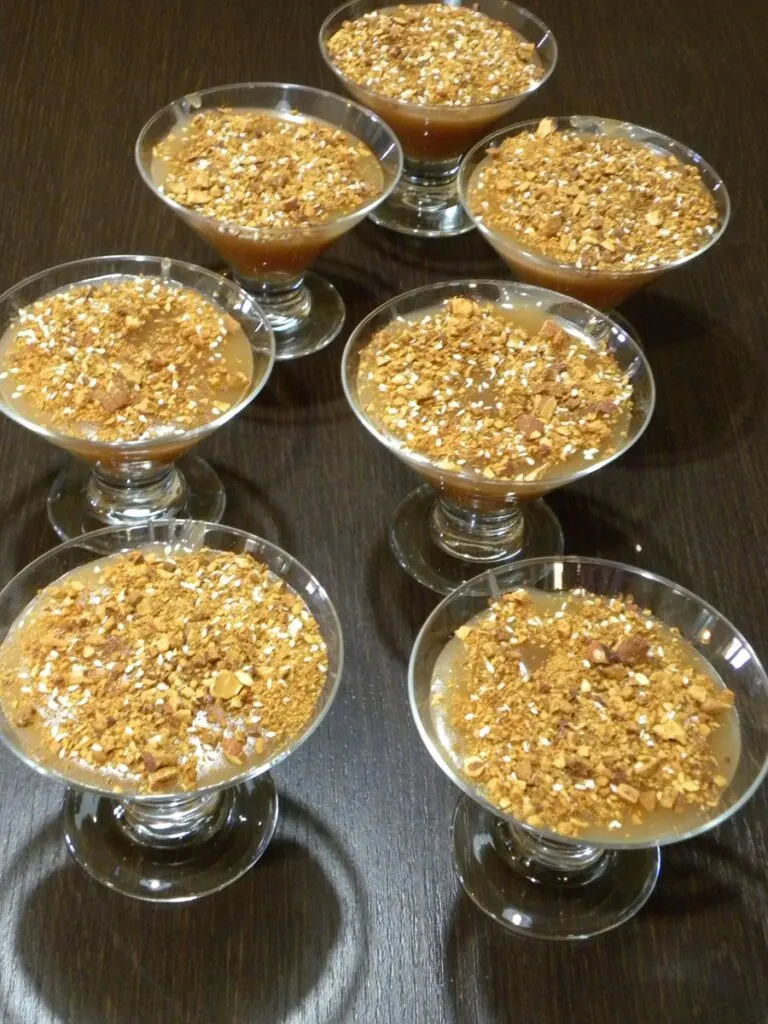
Every recipe you will be reading today has to do with “GRAPE MUST” but the only thing I made myself was palouzes (moustalevria).
The other are just an explanation of what they are and how I remember them being made.
Making Palouzes the Traditional way
The traditional way of making palouzes was quite complicated as I remember my mother would make large quantities.
Of course, all the family and even friends or neighbours were there to help.
They would add a special white soil to the must, yes that’s right soil, which after boiling, helped to remove all the impurities from the must.
(See note in comments by Niki: The soil that is added to the grape juice is in fact chalk and as an alkaline, it neutralises the acid giving a sweeter taste to the end product).
It was boiled in big caldrons called “chartzia, again in Cypriot dialect”and passed from sieves several times.
It was a quite tedious procedure as the pressing of the grapes is not easy.
They used to do this using their feet (grape stomping), same way when taking the juice to make wine) and would prepare an outdoor fire to cook it.
When the first step of boiling finished, after it cooled down they would remove it from the caldron in other pots and whatever residue rested in the bottom, they would pour away.
After that they would put it back in the caldron, add the flour and stir it with a large wooden stick until it would set. That procedure was very difficult as well.
The pudding was flavoured with kiouli (arbaroriza in Greek) which is the fragrant geranium leaves, or if they didn’t have any, with vanilla or mastic gum (resin).
They would then put the pudding in bowls and some in large baking tins. In the bowls they would sprinkle some cinnamon and crashed almonds or walnuts on top.
The pudding would be eaten either warm or cold. With the remaining they would either make shoushoukos or kiofterka.
Easy way to make Palouzes – Moustalevria
The moustalevria I make is a much more simplified way of making this pudding. This recipe was given to me by my elder sister Zoe.
The recipe is included in my cookbook Mint, Cinnamon & Blossom Water, Flavours of Cyprus, Kopiaste as well as in Volume 2 of my e-cookbook, sold on all Amazon stores.
The recipe that follows is made with a mixture of both moustos (grape must) which I bought at the farmers’ market and petimezi – epsima (concentrated grape syrup) so the preparation is much easier.
I must warn you that if you decide to make this dessert from scratch, when you finish you’ll end up with a very messy kitchen but it is worth while to make it at least once.
If you have a juicer the procedure is much easier or if not, use a food processor and a strainer to strain the juice.
However, in Greece you can buy “grape must” at the farmers’ market or at wineries during September – October.
Usually, this ready made grape must is boiled and cleaned from impurities, so the only thing you need to do is to add the flour and mix until it sets.
Other desserts or products made with Grapes
Petimesi or Epsima, in Cyprus (Concentrated Grape Syrup)
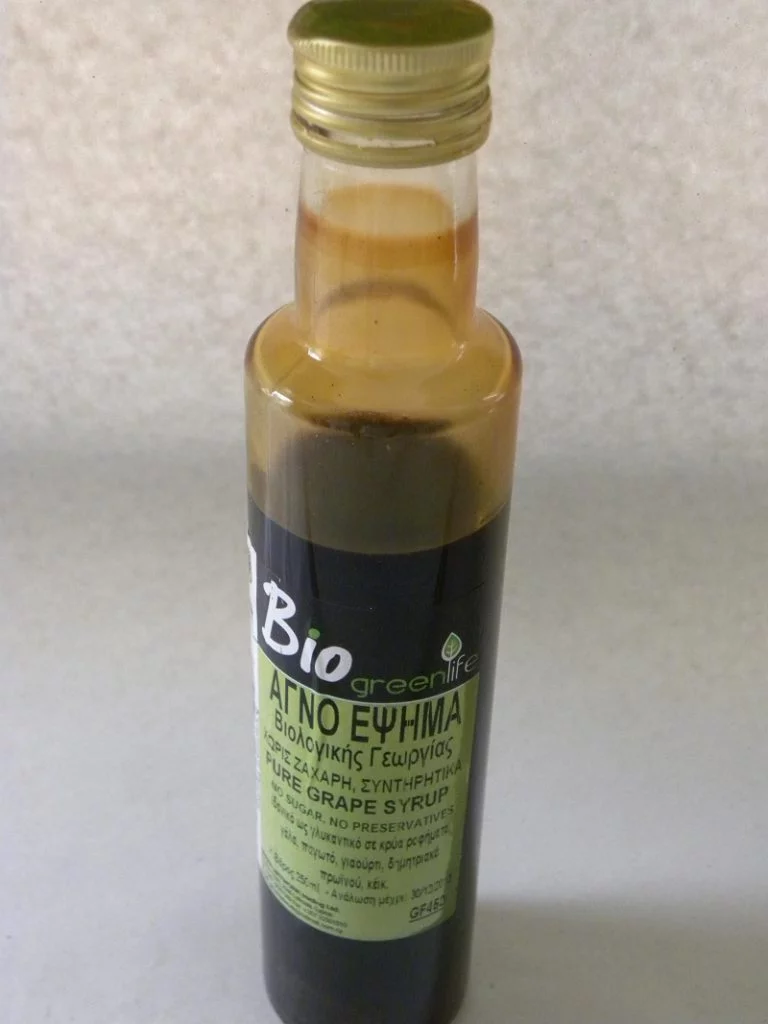
“Epsima”, or petimezi as it is called in Greek is made from black grapes and is known for thousands of years.
Athinaios, the ancient Greek nutritionist and writer wrote about a fish recipe where a hint of epsima was used and he states that creations like those were why people did not become cannibals.
When boiling the grape must for a long time (no sugar is added) it concentrates into a sweet syrup. It’s Cypriot name “epsima” comes from the ancient Greek word afepsima (αφέψημα) which means to brew.
In the old days they did not have sugar, so apart from using honey, during summer, when sweet fruits were abundant they made natural sweeteners from sweet fruit such as grapes, figs, pomegranate or carobs.
See my recipes for Chocolate Pudding with Petimezi or Halvas with Petimezi.
The flavour of these syrups is amazing but most of all they are way much healthier than any other sweeteners, as they contain antioxidants, vitamins and minerals.
Beneficial properties:
It is rich in energy, iron and calcium. It does not contain preservatives, artificial colourings or sugar.
It is preserved for a long period without having to refrigerate it.
It concentrates most of the therapeutic ingredients of the grape and is usually used:
- Served in small “morning shots” for immediate energy empowerment: excellent source of iron (anemia), for sore throat treatment, as an antidepressant.
- For marinades in cooking, especially with vinegar, in sweet and sour sauces and salads using balsamic vinegar.
- In confectionery as a sweetener, in beverages, with Greek yoghurt, or to make cookies called moustokouloura, pishies, kattimerka, halvas, to top homemade pancakes or xerotigana, on which they added epsima instead of honey.
A very simple dessert my mother used to make was souppouthkia. She fried small cubes of stale bread, and after frying the bread, the remaining oil would be discarded and epsima was added to make this simple dessert.
My mother would also make “koulourouthkia me to epsima”, which is made of dough which she shaped into small spiral rings.
The same “koulourouthkia” were also made with teratsomelo (charoupomelo, in Greek), which is carob syrup.
These were cooked like pasta, then most of the water was discarded and epsima or teratsomelo (carob syrup) was added. They were cooked for a few more minutes to absorb the syrup.
Nutritional value of epsima (% per 100 g) / Carbohydrates 80.9 / Fat 0.4 / Proteins 0.9 / Calories 33 / Calcium 74mg / Phosphor 40mg / Iron 1.2mg
Grouta:
Palouzes (moustalevria) was made during the autumn with fresh grape juice.
During winter, they would use epsima to make grouta, which is similar to moustalevria.
The concentrated grape syrup was then diluted in water and made a pudding which they thickened with flour.
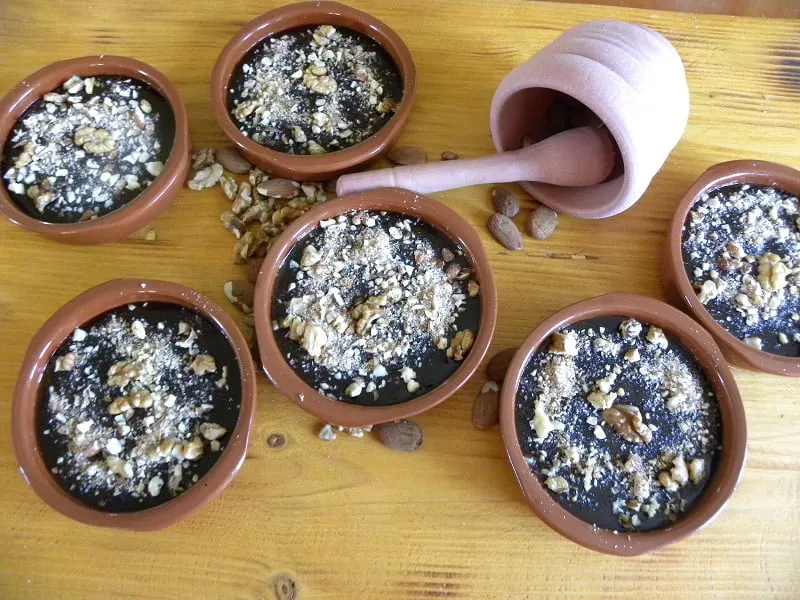
Shoushoukos or soutzioukos:
The other product made of palouzes was shoushoukos or soutzioukos.
Shoushoukos is a candy made with grape pudding and almonds and some times with walnuts.
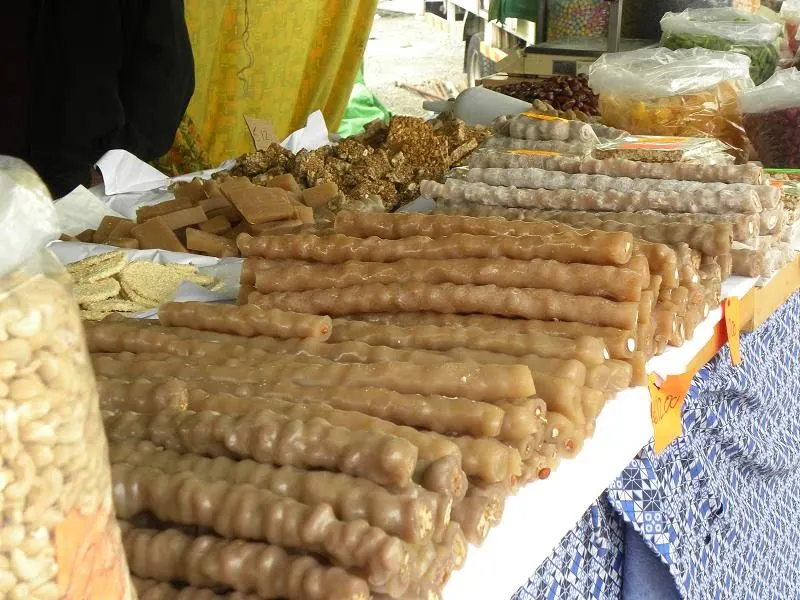
To make it, they would thread almonds with a needle and when the palouzes was ready, they would hang these threaded almonds on a stick, shaped with an upside down V, which they cut from trees (now they hang them on metallic ones) and dip them in the mixture about four times, until the almonds were covered with the grape pudding.
They would hang the threads and some of the mixture would drip off. The following day they would make a new palouzes and would dip the threads again.
They repeat this procedure the following day until the almonds are totally covered and the candle or sausage shaped product becomes about 1 inch thick.
In order to store this candy for the winter months, they hang the threads in the shade and these will dehydrate. This way they can be preserved for the winter ahead!
Last October when I went to Cyprus I brought a lot with me and still have some in the refrigerator.
Some of it I wrapped in cling film and placed it in the deep freezer and when I defrosted it, it was as fresh as when I brought it with me.
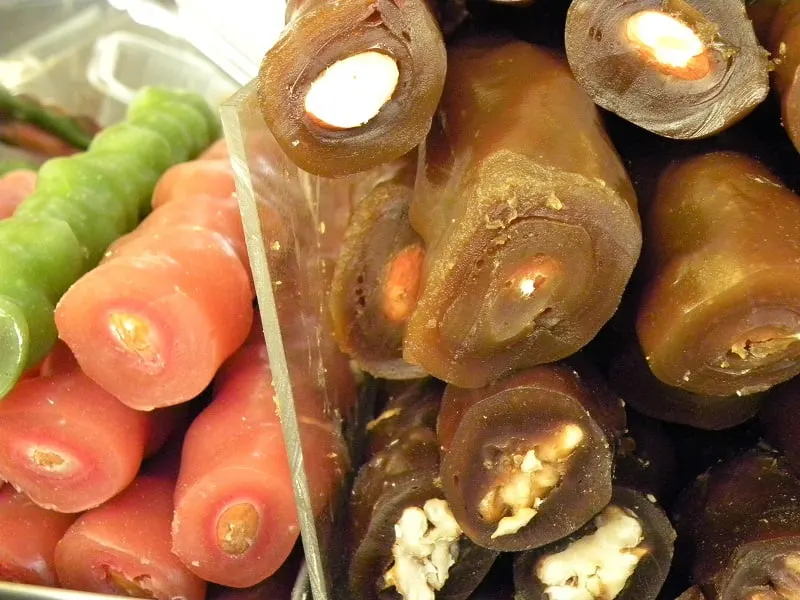
Recent variations are made with pistachio, pomegranate or carob.
Kiofterka
Kiofterka blocks made of dehydrated palouzes.
As I said above, they would make large quantities as apart from eating palouzes, they would make shoushoukos out of the same mixture and what was left, they would make kiofterka.
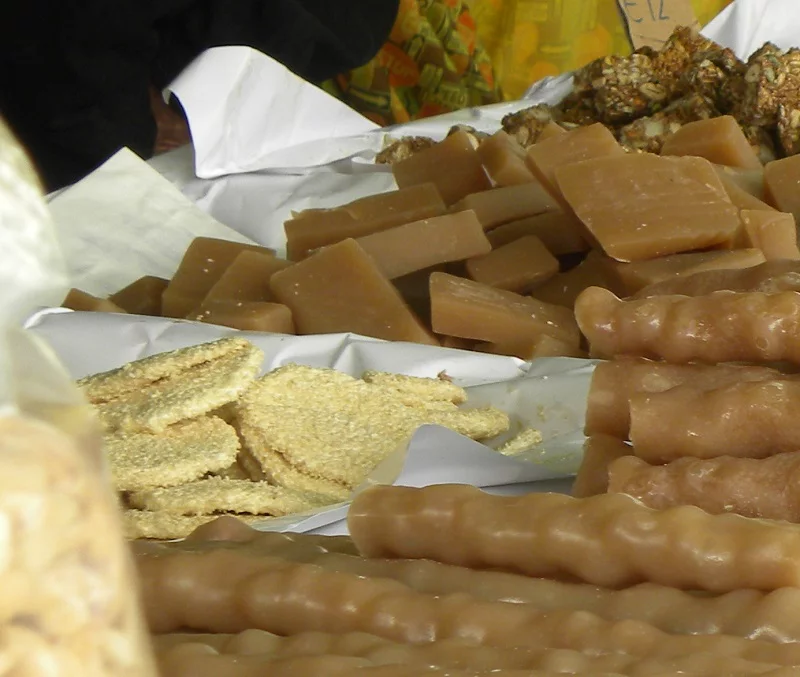
To make kiofterka, after making palouzes and shoushoukos, they put the leftover pudding in big baking tins and leave it a couple of days.
They then cut it into rhombus (diamond shaped) or rectangular pieces about 3 X 2 inches long but not very thick, about ½ inch thick and leave them in a “tsestos” to dry for many days in a shady place, to dehydrate.
They become hard but chewy but still delicious and they eat these as well as a snack during winter.
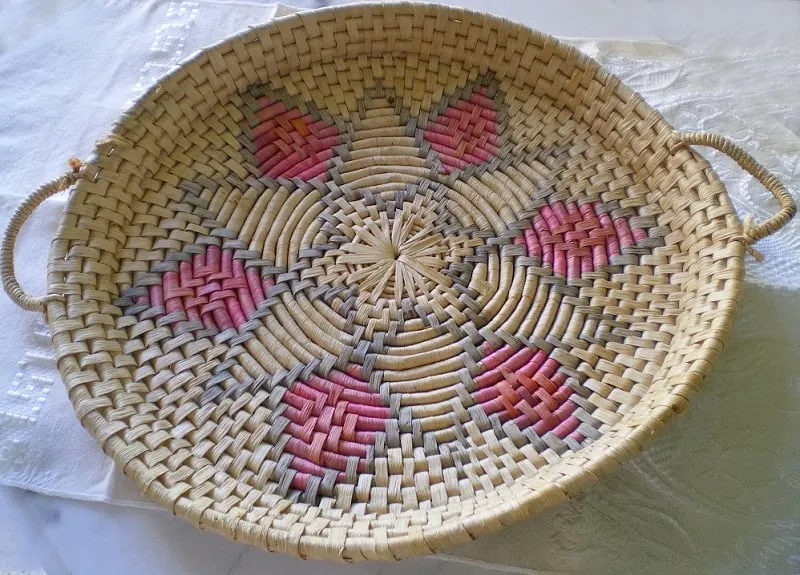
Tsestos was a traditional handmade shallow basket made either from palm leaves, rope from stubble or straw.
These were a must in the traditional Cypriot household, in many colourful designs and sizes.
They were used to carry objects such as koulouria, when they invited people to weddings, to dry trahanas, to cut fides (angels’ hair) or other pasta, to place the bread or flaounes to rise, during Easter, to dry kiofterka etc.
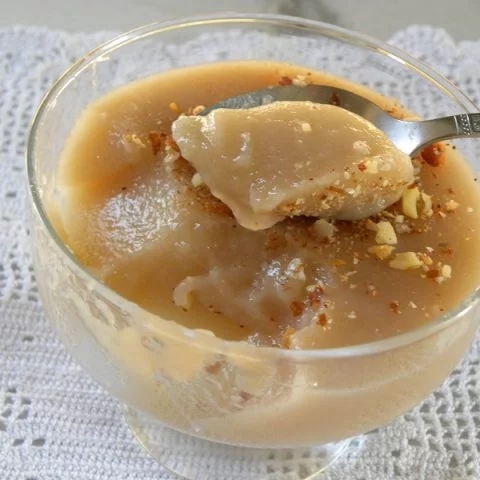
“Must” make Palouzes (Moustalevria) and Shoushoukos
Palouzes, in Cypriot dialect or Moustalevria, is a pudding made with either fresh grape juice during autumn or with concentrated grape juice (petimezi or epsima, in Cypriot) when no fresh juice is available.
Ingredients
- ½ litre fresh grape juice
- 1/2 tsp baking soda
- 1 cup concentrated grape juice (petimezi)
- 1 cup water (or substitute amount of grape juice with more water)
- ½ cup all-purpose flour
- 2 tbsp corn flour (starch)
- 2 - 3 arbaroriza / kioulia (fragrant geranium leaves), (optional) or add vanilla
- 3 tbsp citrus blossom water
- ¼ tsp cinnamon powder
- 3 tbsp crushed almonds (you can roast them if you want)
- 3 tbsp crush walnuts
- 1/2 tsp sugar (optional)
Instructions
- Boil the grape must together with the baking soda and the fragrant geranium leaves for five minutes. Be careful when adding the baking soda, as it may overflow.
- Set aside to cool.
- Dilute the flour and corn flour with the water and mix in the concentrated grape juice. Discard the fragrant geranium leaves and add this mixture to the grape juice.
- Mix continuously with a balloon whisk until it sets.
- Pound the almonds and walnuts and mix in the cinnamon and sugar.
- Wet a bowl with the citrus blossom water. Empty it in another bowl and continue until all are wet. Empty any leftover in the pudding and mix.
- Divide the pudding in the bowls and sprinkle with the almonds and walnuts on top.
Nutrition Information
Yield 6 Serving Size 1Amount Per Serving Calories 176Total Fat 5gSaturated Fat 0gTrans Fat 0gUnsaturated Fat 4gCholesterol 0mgSodium 30mgCarbohydrates 31gFiber 1gSugar 19gProtein 3g
The recipe for palouzes is included in my cookbook “Mint, Cinnamon & Blossom Water, Flavours of Cyprus, Kopiaste!“
I am submitting this recipe to Weekend Herb Blogging hosted by Srivali, of Cooking 4 all Seasons and created by Kalyn, of Kalyn’s Kitchen.
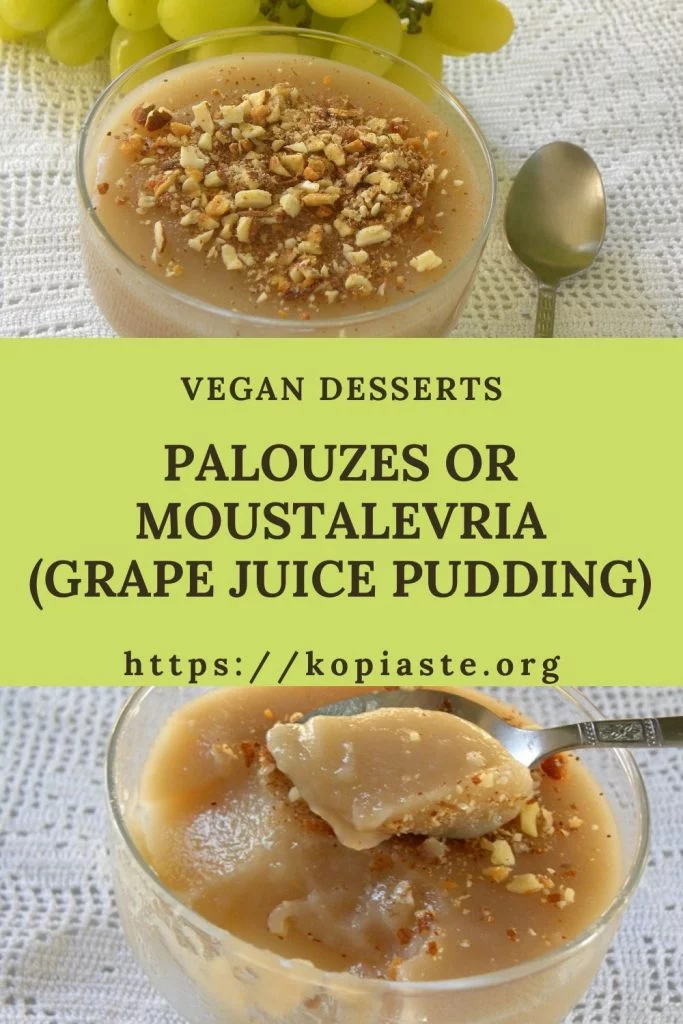
Kopiaste and Kali Orexi,

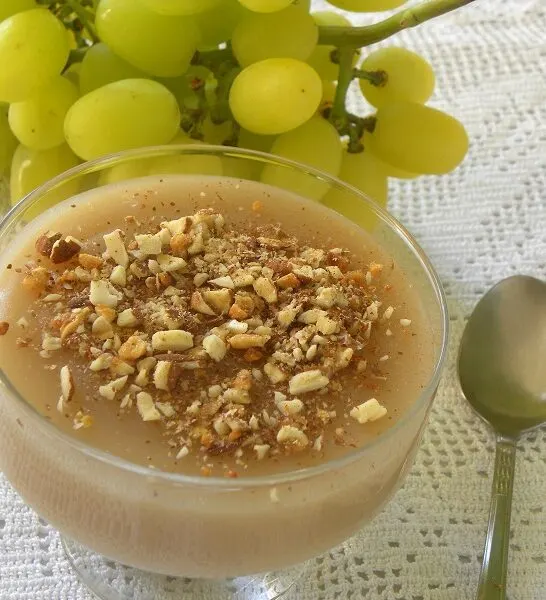
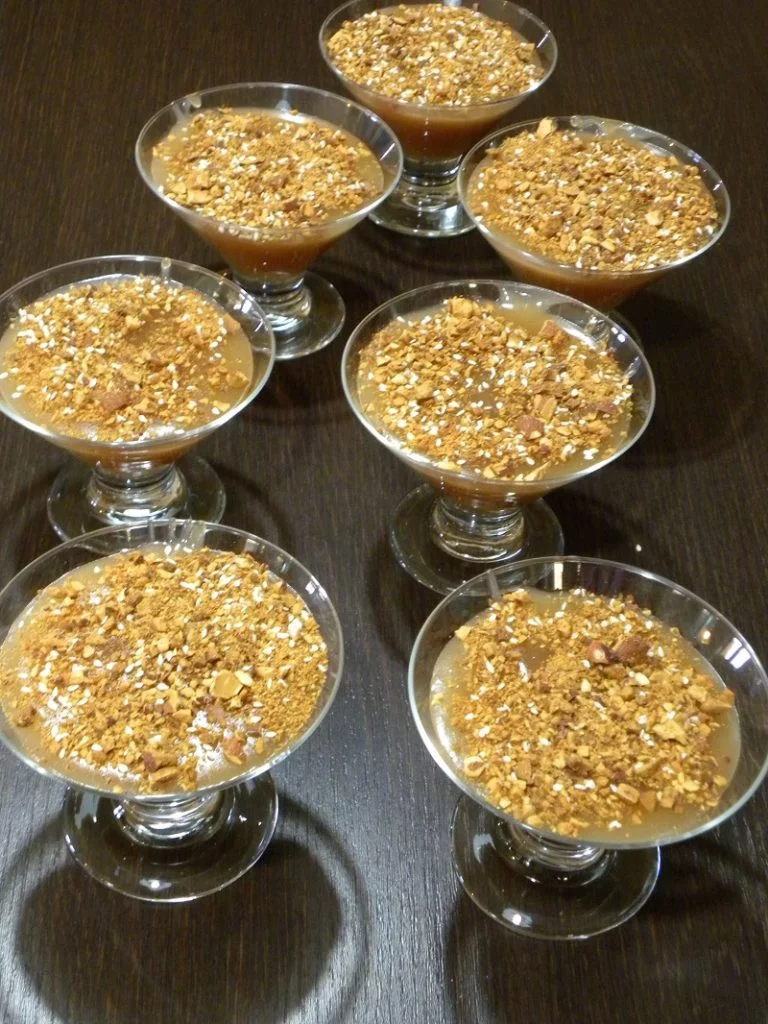
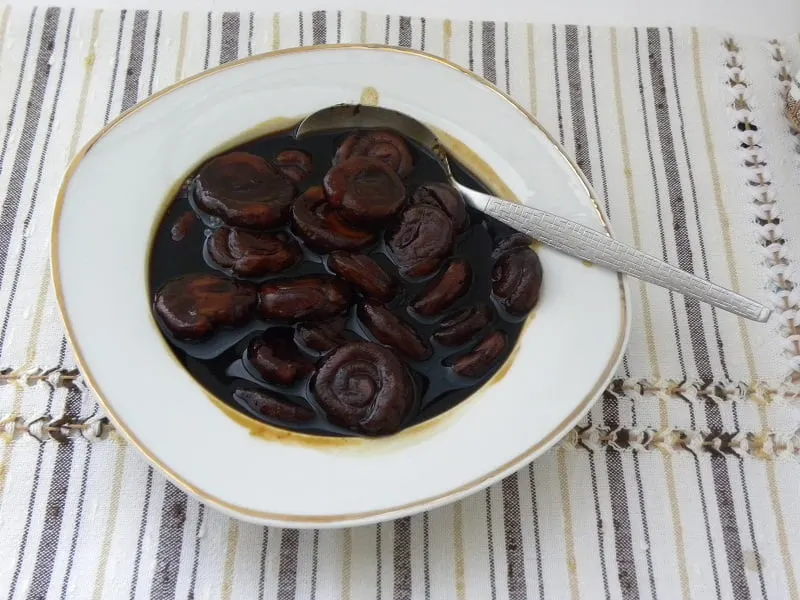
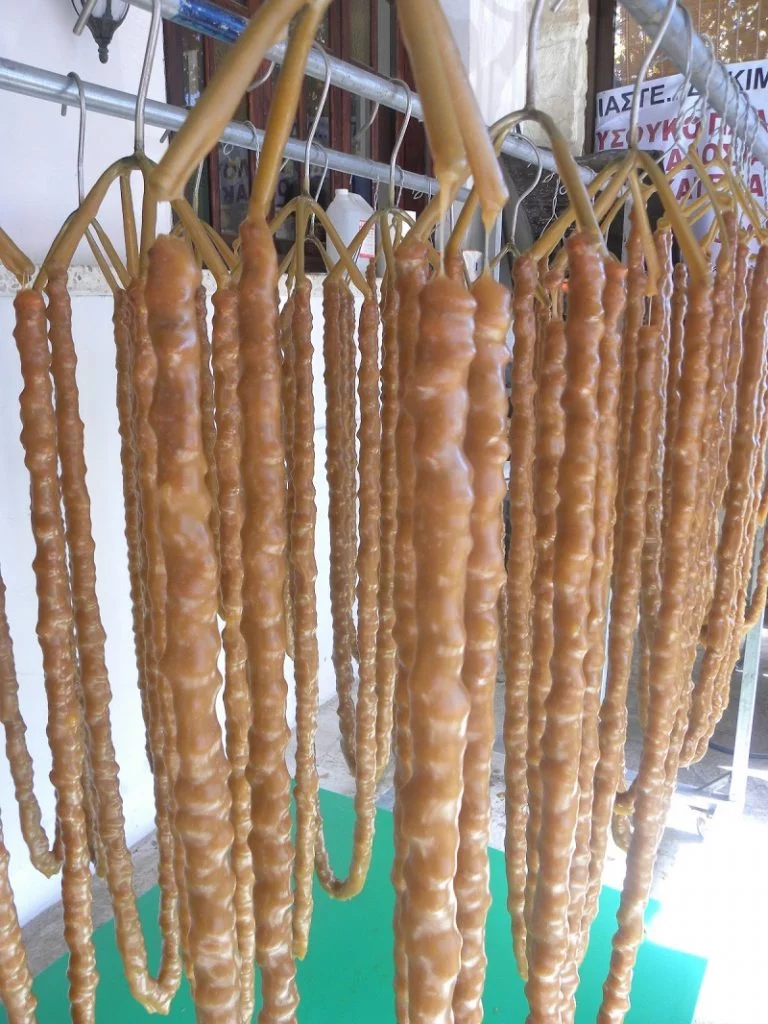


PETER CHOVANEC
Tuesday 22nd of September 2015
Hi, dear Ivy. I was last year in november in Troodos mountains in Cyprus. The fresh Shoushoukos I had tasted there are best all of the world...! I try to produce it at home, but still without satisfied results.. :0( Please tell me, Do I have to reduce contents of grape juice by boiling 3 hours to sirup before add flour ? What is the exact ratio of juice and flour? ( 1 liter - 100g) ? Do I have to use corn of wheat flour ? How to clean syrup without special white earth...? Thank you for your help Peter from Prague
Jackline
Tuesday 21st of July 2015
Thanks a lot for shring thess amazing recipes , waiting for other recipes sooon , I enjoy reading your posts as well.
Peter
Monday 16th of March 2015
I've tried moustalevria in Greece but I think it was with petimezi. I've never made it myself. This sounds quite easy and I am going to try it soon.
P Pieretti
Thursday 12th of June 2014
I can't seem to be able to find the actual recipe (for palouzeh).
Jannet
Tuesday 8th of January 2013
Ivy I am bookmarking your blog. Food, nutritions, we take in regular life, you make it great with your recipies. I will come again for a new post from you. Thanks